One of the ways that helped me to speed up my weight loss results with the OMAD diet was to do consistent exercise.
In this article, I will cover how to combine one meal a day together with exercise, whether you are doing cardio, strength training, or both.

Do you have to exercise on OMAD?
Eating only one meal a day does create a negative energy balance (without breaking a sweat in the gym). So exercise on OMAD is not essential, but highly recommended.
I rarely look at exercise as a weight loss tool, but rather as a way to boost my energy.
According to studies, physical activity is responsible for 15% – 30% of calories burned (see below).
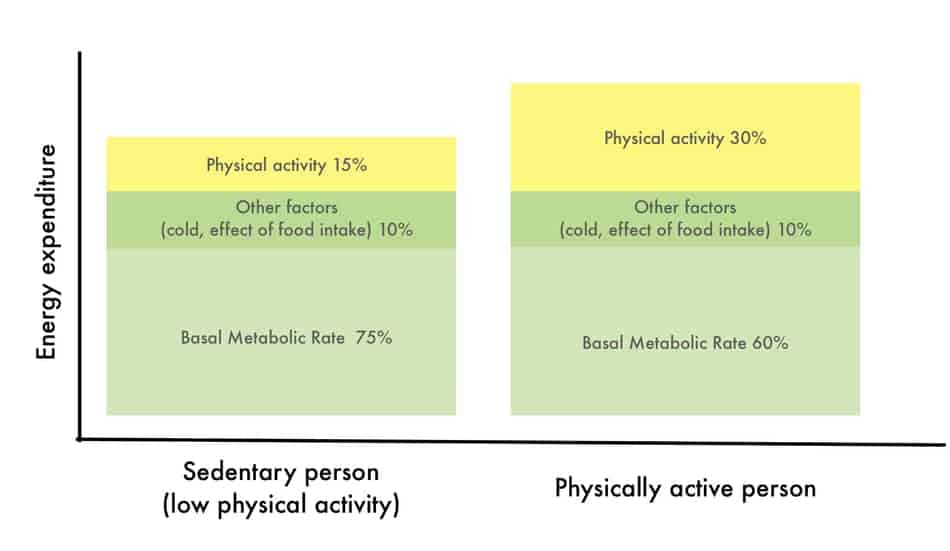
(Image source: PMID: 30695621)
The majority of calories are used for basal metabolic rate, which is the total energy needs to perform basic functions like breathing, digestion, or blood circulation.
In other words, won’t see significantly better results from extra calories burned with additional exercise.
So OMAD does work without exercise and if you don’t like to lift weights, there are several ways to stay active.
Benefits I’ve experienced with practicing OMAD and exercise
I’ve been doing OMAD for over a year and I find that daily exercise, even if it’s only 20 minutes, helps me to combat my stress, suppress my appetite, and give me more energy.
Although I’ve been experimenting with many different diets for many years, I noticed that lifting weights and doing strength training helps to maintain my weight loss results, without losing muscle mass.
Here are the benefits that I’ve experienced doing OMAD together with working out.
Weight loss
Although eating one meal a day is enough in itself to lose weight (without stepping foot in the gym), I prefer to have some muscle mass. I don’t wanna be that lean and skinny guy. I rather have some muscle on me.
Here you have a photo of my gym workout. (Yes, I’m wearing Havaianas flip flops during my resistance training days.)
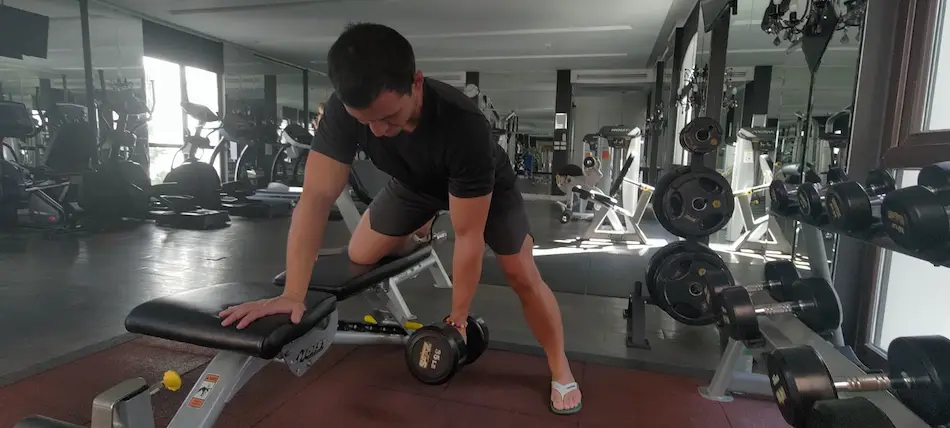
Doing OMAD and regular strength training helped me to maintain my muscle mass while losing stubborn belly fat. (My gym is around the corner so I can train every day.)
One of the reasons why people lose muscle during weight loss is the lack of strength training with progressive overload, according to experts.
I gain 4 lbs of muscle mass
You can build muscle on OMAD, as long as you include enough protein and choose strength training as your physical activity.
I recommend doing full-body workouts that cover all major muscle groups like the chest, back, legs, and glutes. Although I train every day, I spend only 3 days per week lifting weights.
Lower stress
I always feel better after a short gym session. As much as I like being lean, I hate calorie deficit because it often makes me think more about the food.
Adding exercise was important because it helps me to control my emotions, reduce my anxiety, and focus my energy on what is important to me.
Here you have a photo of me playing around in my gym with a punching bag.
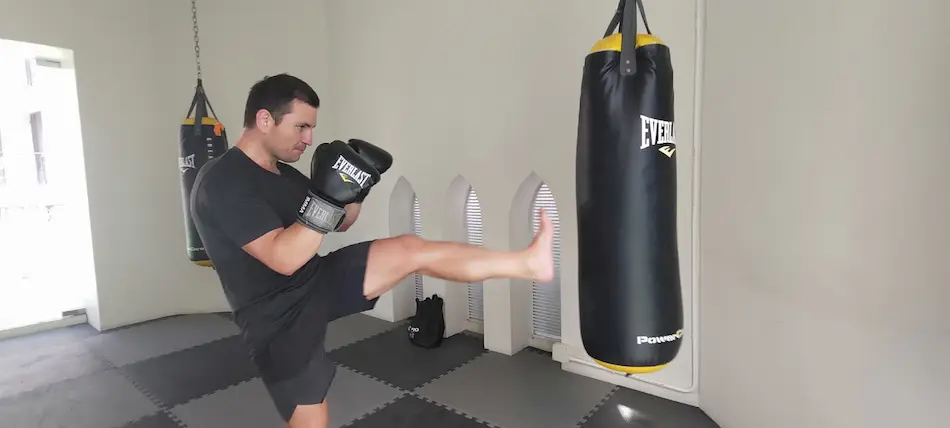
Seriously, I find that punching the bag works best to reduce my stress.
I can have tons of things on my plate (which happens a lot) but once I hit the bag or do a full-body workout, all of a sudden, my head is clear and I have the energy to deal with these problems.
Feeling less hungry
For most days, eating one meal a day makes me feel hungry. My hunger peaks around 1 pm and that’s when I often go to the gym.
I noticed that after my workout (cardio or weights) my hunger levels can stay at bay. I can easily get back to work, and wait for my meal till the late afternoon.
According to the article from the Nutrients Journal published in September 2018, exercise promotes weight control, partly through effects on appetite regulation.
The research states that “single bouts of exercise induce a short-term energy deficit without stimulating compensatory effects on appetite.”
Better sleep quality
Ever since I started doing my 45 minutes of low-intensity cardio sessions, my sleep improved (significantly).
Not only I can fall asleep without any issues, but I also wake up rested and feeling energized. For my cardio, I often do walking or low-impact cycling classes on my peloton bike.
I try to stay away from high-intensity workouts as these often get my heart rate up, make me more alert and I struggle to sleep.
“Physical activity has been shown to have a positive effect on stress reduction by stimulating the parasympathetic response and releasing melatonin and endorphins. Those hormones help you feel good and sleep better,” says the researcher from the University of Graz, Franziska Matzer Ph.D.
In her recently published randomized controlled trial, Dr. Matzer explains “physical activity has stress-relieving potential via lowering systolic blood pressure.”
Gives me more energy
I’ve noticed after workouts I can do more things, stay more focused, and be more efficient in my work. This improves the quality of my day. And if I can do that every day, that’s a better quality of life.
On the contrary, if I skip my workout, immediately my mood change. I become more sensitive to things that normally wouldn’t bother me.
How to do OMAD diet and exercise
Apart from the laundry list of health benefits that come from physical activity, working out on one meal a day helps me stay focused and mentally strong to fight any setbacks that come along the way.
Although I love to train, I also like to keep things simple. I don’t follow a complicated workout plan for hypertrophy, but rather do what makes me happy and allows me to enjoy my training.
These steps can help you stay active on the OMAD diet while having fun and energy for the day.
Start slowly
If you’re new to exercising, it’s important to start slow and gradually increase the intensity of your workouts.
Start with 20 minutes of moderate exercises, such as walking or light jogging, three times per week. Find the smallest version of your workout that feels good, and do at least that.
Prioritize lower intensity
For me, exercise is double edge sword. It can either help me to reduce, or increase my stress, depending on what I do.
For me, doing HIIT workouts on OMAD is fun, but it often makes me feel lethargic and hungrier later if I do them every day.
Instead, I rather do heart rate zone 2 training, a low-intensity cardiovascular exercise that keeps your heart rate within 60-70% of your maximal heart rate.
Here is a look after my zone 2 training (my face is completely wet from sweat).
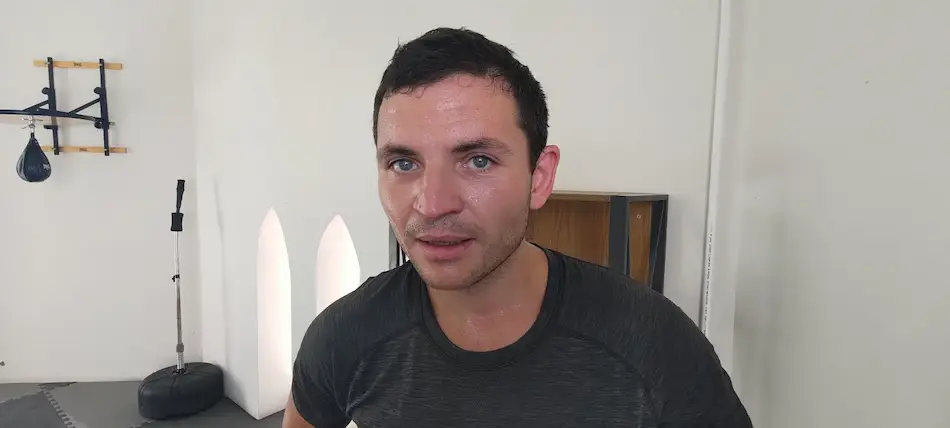
I noticed I sweat the most when my heart rate gets up to 120-130 beats per minute.
According to the study published in the Frontiers in Physiology Journal, training at this intensity has been shown to reduce the risk of overtraining, increase mitochondria density, and help to speed up recovery.
Set realistic goals
It’s important to set realistic goals (and expectations) for yourself. Trying to do all things at once never worked well for me.
Exercising more may burn more calories, but losing too much weight too quickly has been shown to reduce resting metabolic rate, compared to gradual weight loss.
Instead, focus on losing one to two pounds per week in accordance with the Centers for Disease Control and Prevention (CDC) guidelines.
I know this may seem to feel like a slow process, but it’s a healthy rate of weight loss that can help you keep the weight off in the long run.
Choose your activity
Choose exercises that can help you burn calories and tone your body, but are also enjoyable. If treadmills and ellipticals are not your things, sign up for a local yoga class, hire a personal trainer, or go outside for a walk.
Here is the photo from my walking session where I discovered a nice outdoor gym with dumbbells!
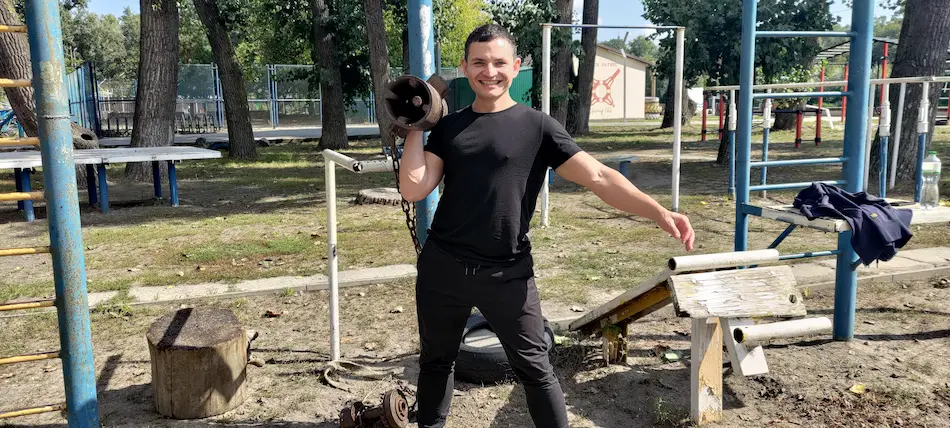
Don’t underestimate walking as this exercise allowed me to lose over 20 lbs of weight, without stepping foot in the gym.
Play sports
You can try and experiment with different sports like golf, hockey, kayaking, basketball, football, tennis, volleyball, or water polo.
Martial arts
Martial arts are not only fun but also teach valuable skills like courage, self-confidence, and respect. You can try boxing, kickboxing, judo, Brazilian jiu-jitsu, karate, or taekwondo.
Get an active hobby
If you don’t like gyms, but you enjoy working with your hands, try to get some active hobby. Things like gardening, bowling, archery, car repairing, or woodworking are good to start.
Be Consistent
Once you find the activity that you like, do it regularly and stick with it long-term. My weight loss changes didn’t happen over one weekend, but rather after months of training and dieting.
I often like to experiment and change things around to make my workouts more fun and interesting. Changing your workout routine, taking part in community sports events, or learning how to dance can make things fresh again.
Support your movement routine
If you struggle with time, purchase some helpful home gym equipment. Look for places you can train. Find a nearby gym, a park to exercise, or a trail to walk. If necessary, purchase a road or MTB bike. Get a pair of new running shoes.
Spend more time moving
When ready, start increasing your workout duration, frequency, or intensity. If you cannot squeeze in more time for fitness, start walking or biking to work, schedule a walking meeting with your spouse, or take a 3-minute break every hour to move.
Listen to your body
These days, I rarely train as hard as possible. I often look for my workouts as a way to boost energy, rather than doing sets to failure.
When you’re dieting and exercising, it’s important to listen to your body and give yourself time to rest when needed.
If training every day seems excessive, add more recovery days. Overtraining can lead to burnout, which can slow your progress.
Have fun
When I’m dieting, I give more attention to doing fun things. (This keeps my mind fresh and helps to unplug.)
You won’t see me in the gym doing the same wokrouts every day. (Yes, I don’t like to get bored.)
I like to play around and do something different.
When I feel like doing something different, instead of doing any squats or push-ups, I take a balloon, tennis ball, or big pilates ball and start goofing around.
If I train with someone, I like to chase the ball, run after the balloons, tap the knee, tap the shoulder, etc.
I also like boxing, playing water polo, going to a dance class, or playing frisbee at the park with my niece and nephew.
What is the best time to exercise on OMAD?
The best time to exercise on OMAD is between 12 pm and 3 pm because you have enough energy to perform the exercise, and you don’t have to eat late at night. Keeping the exercise intensity low and using workouts as an appetite suppressant will help you stay consistent, without burning out.
If you’re in a position where you manage your own schedule and you can choose your exercise time during the day, then, in my opinion, the afternoon is king.
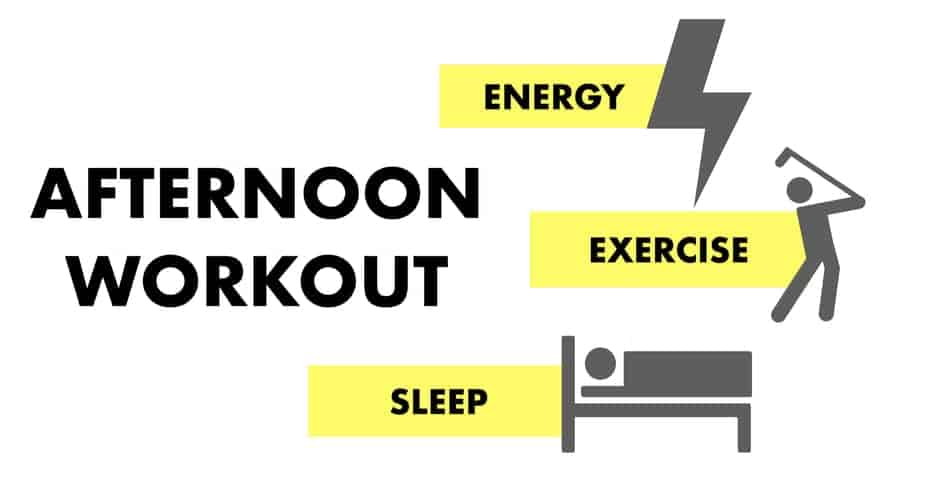
If you have one meal a day in the afternoon or early evening, the most difficult time that you will feel hungry is noontime. This is the perfect opportunity to plug in your workout.
It can energize you and push you through the rest of the day until your meal. It will help you not to feel so hungry and clear your head from any anxiety.
Also, because you eat after the meal, it will lead to the most optimum results. So as you can see, it checks all the boxes.
Should you do a workout in the morning on OMAD?
You can do a morning workout on OMAD if you don’t have any other option. For the morning, start by adjusting your workout intensity.
Try walking, stretching, or weight training with long rest in between. If doing HIIT or another high-intensity exercise, don’t go more than 20 minutes as it may lead to lower energy later on during the day.
I also find that morning workouts make me feel more hungry. Initially, I feel energized and invigorated, but as the day goes by, my stamina goes down like a sinking ship

Should you do a workout in the evening on OMAD?
Exercise in the late evening often makes me feel awake at night. And, if I don’t sleep well, the next day I say hello to poor performance, overeating, and a lower willingness to train.
Also, I try to stay away from exercise after eating. Having a big meal late in the evening does mess up my stomach.
On the other hand, if I don’t eat all day and then train and then finally get to eat, I feel exhausted. So, yes you can do a workout in the evening on OMAD, however, choose your intensity wisely.

I may get away with this routine for a couple of days or even a couple of weeks. But sooner or later, it often catches up with me, so it’s not the best idea.
When I workout on the OMAD diet?
I often choose to exercise in the late morning or early afternoon. If I exercise too early, I may experience a drop in my mood and energy for the rest of the day.
If I train too late, I often can have a hard time falling asleep (depending on the type of exercise).
The afternoon is my sweet spot.
Of course, this will totally depend on my workflow. If I’m all day at work, and the only realistic time to work out is after work, then I try to change my workout plan for something relaxing.
Should I exercise before or after one meal a day?
Doing OMAD after a workout will get you better results and help to reduce your appetite.
Doing OMAD before a workout isn’t recommended, because your body switches into the parasympathetic mode and keeps the blood in the stomach area to help digest food, which can make you feel lethargic.
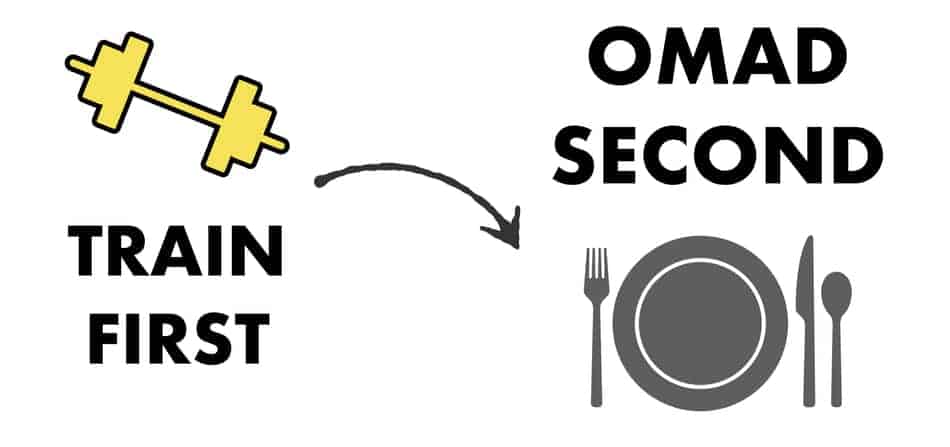
According to a comparative study from 2013, during digestion, our body moves the blood away from the muscles and keeps it around the stomach and intestine area. This is popularly called the rest and digest effect.
Exercising during this time pumps the blood away from the stomach back into the muscles and can lead to digestion problems.
According to the aforementioned study, “exercise before your meals leads to better fat oxidation. After you train, your body increases insulin sensitivity and your muscles absorb the majority of the glucose.”
So there is a big difference between doing OMAD before or after a workout. For the best results, you want to do OMAD after a workout.
Working out twice a day on OMAD?
Working out twice a day on OMAD won’t bring you any extra benefits but instead can lead to tiredness and breaking down under too much pressure. However, exercises like light walking or stretching can actually enhance the process by suppressing the appetite and cravings.
This means if you’re choosing to exercise twice a day on OMAD, you must carefully decide on what type of exercise you are willing to do.
It is much better to stay with low intensity and be more consistent, rather than do high-intensity cardio sessions.
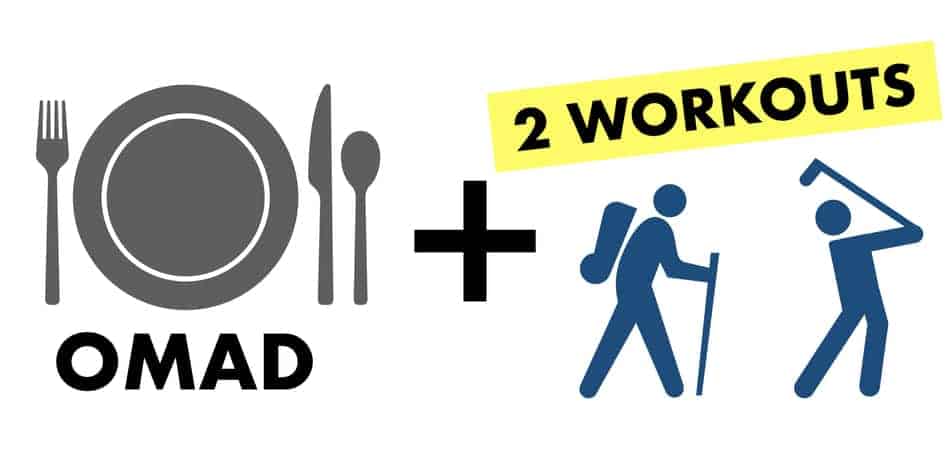
Conclusion
Doing OMAD with exercise was a game-changer. If you are on the fence, I recommend starting with something easy, just the get the habit of being physically active.
Start from light Light walking, stretching, fun activity, sex, and playing games, are all great ways to reduce cortisol. This means your stress level goes down and you are more likely to continue this path.

I’m a month into OMAD (with the occasional break) and I’m doing light weights and cardio 4 times a week. I’m feeling better in my moods, outlook and physically, so for me I feel I’ve made the right decision. This is probably one of the best articles I’ve read on OMAD and exercise. You’ve answered most of the questions I’ve had and I’d highly recommend it as a useful and most importantly, practical guide to anyone interested in the subject. Thanks for sharing!
Thank you, Patrick. You’re welcome!